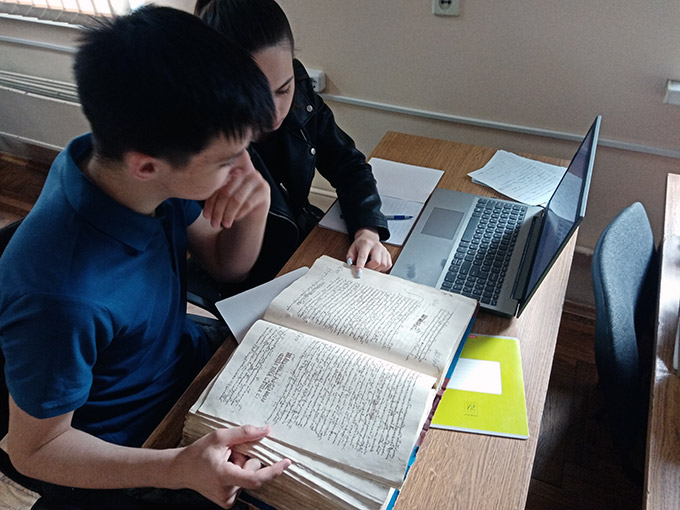On conducting an educational paleographic practice for students of the Faculty of History of BSU
In the period from June 26 to July 15, 2023, on the basis of the state institution «National Historical Archives of Belarus», an educational paleographic practice was held for 1st year students of the Faculty of History of the Belarusian State University, specialty 1-23 01 13 «Historical and Archival Studies» in the amount of 16 people . The practice was managed by Irina Bober, Head of the Department of Ancient Acts, from the institution, and Andrey Latushkin, Associate Professor of the Department of Source Studies, Candidate of Historical Sciences, from the University. The aim of the practice was to create a holistic view of the students about the previously existing and surviving complexes of manuscripts on the history of Belarus of the period of the Grand Duchy of Lithuania, paleographic features and external signs of documents of the XIV-XVIII centuries, as well as consolidating the knowledge and skills acquired within the framework of the academic discipline «Special Historical disciplines. Paleography».
The objectives of the practice were:
– acquaintance with the composition of the funds of the NIA of Belarus of the period of the XIV-XVIII centuries, with the funds of manuscripts of other specialized institutions of the country, the features of their accounting, description, storage and use;
– application in practice and improvement of reading skills of handwritten Cyrillic texts of the XIV-XVII centuries. in terms of working with the original document;
– formation of an idea of the role of paleography in the description of archival documents, in the development of the scientific and reference apparatus of archives, in archaeography;
– the study of the material basis of documents, the practical application of the skills of filigree analysis of manuscripts on paper.
As a result of the practice, its goal and objectives were fully achieved. During the internship, the students met with the administration of the NIA of Belarus, got acquainted with the history, organizational structure, functions of the departments of the institution, its profile and composition of funds, got an idea of the measures to ensure the safety of documents of the period of the XIV-XVIII centuries. work of the archives, listened to a lecture on the history of the Vitebsk central archive of ancient assembly books.
The main part of the time resource of students was occupied by the performance of an individual task. Its contents implied the paleographic processing of two original documents of different times of creation with the text of the Cyrillic script of the 16th – the first half of the 17th century.
For each of the documents, students performed the following types of work:
– reading the text of the document;
– compiling a dictionary of historical concepts mentioned in the text, revealing their meaning through dictionaries of historical terminology, dictionaries of the history of the Belarusian language and other reference literature;
– determining the type of document and compiling a title for it based on methodological approaches that are used in the archival industry as part of the development of a scientific reference apparatus for documents from the period of the second half of the 13th – 18th centuries;
– filling in the table of graphic forms of Cyrillic letters used in the text;
– dating of the manuscript on paper by analyzing the watermark (filigree).
As a basis for the work, documents from the funds of zemstvo, city (castle), Podkomorsky courts of the GDL, act books of magistrates, funds of personal origin (family funds) were used.
Student impressions:
«During the internship, I was entrusted with the implementation of an individual task, which included the independent solution of practical and research problems. I actively used the relevant scientific and methodological literature, as well as filigree albums when performing an individual assignment. As a result of this process, I have acquired significant professional competencies, which are an important asset for my further development in the field of historical and archival studies» (Maxim Karyazhkin).
«I really enjoyed working with ancient texts despite some difficulties in paleography. The staff of the archive was friendly and pleasant in communication. The NIA of Belarus itself surprisingly turned out to be more of an open public place. The fact that in the documents of the 16th-17th centuries people are also worried about the same problems that we are: the sale of property, a lawsuit for securities, and the like is also a cause for a smile. In general, the impressions from the practice are positive» (Matvey Udovkin).
In the photo: Paleographic practice of BSU students in the NEA of Belarus






